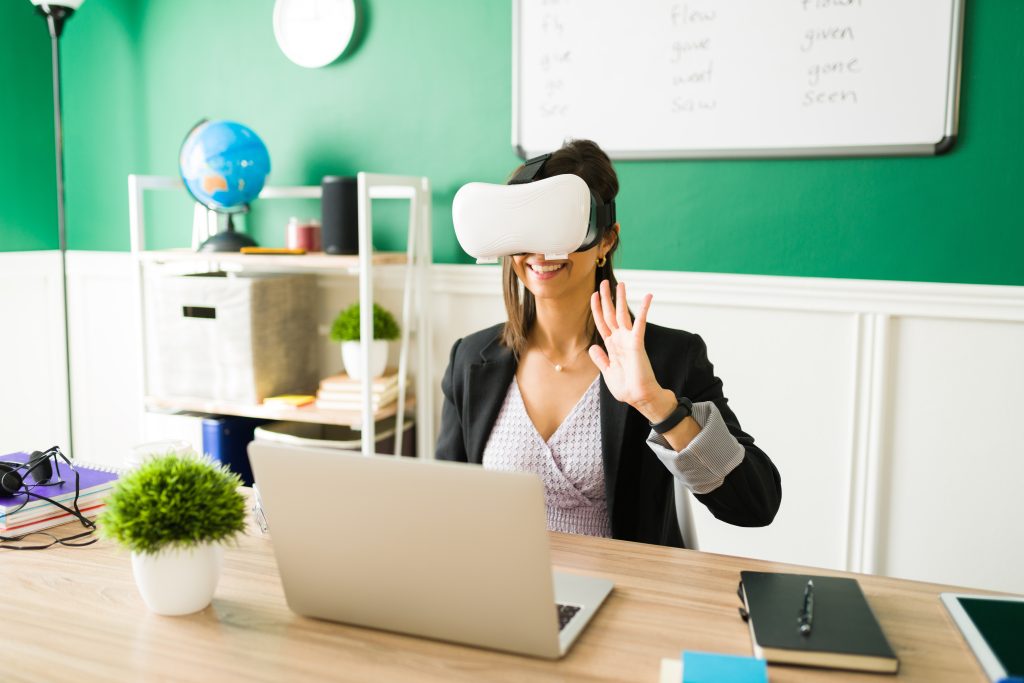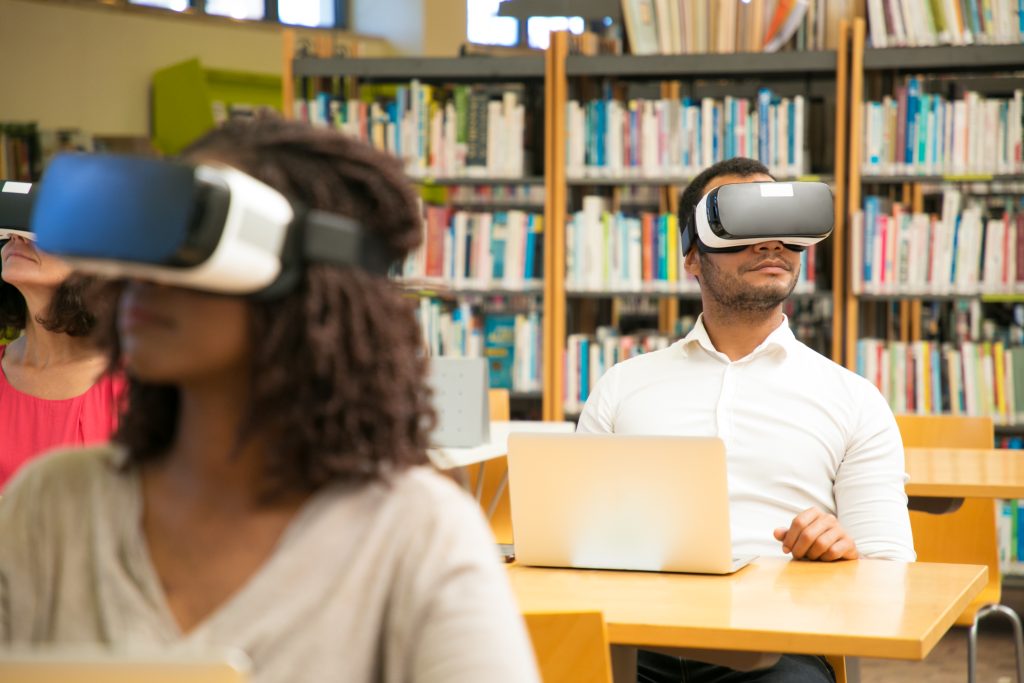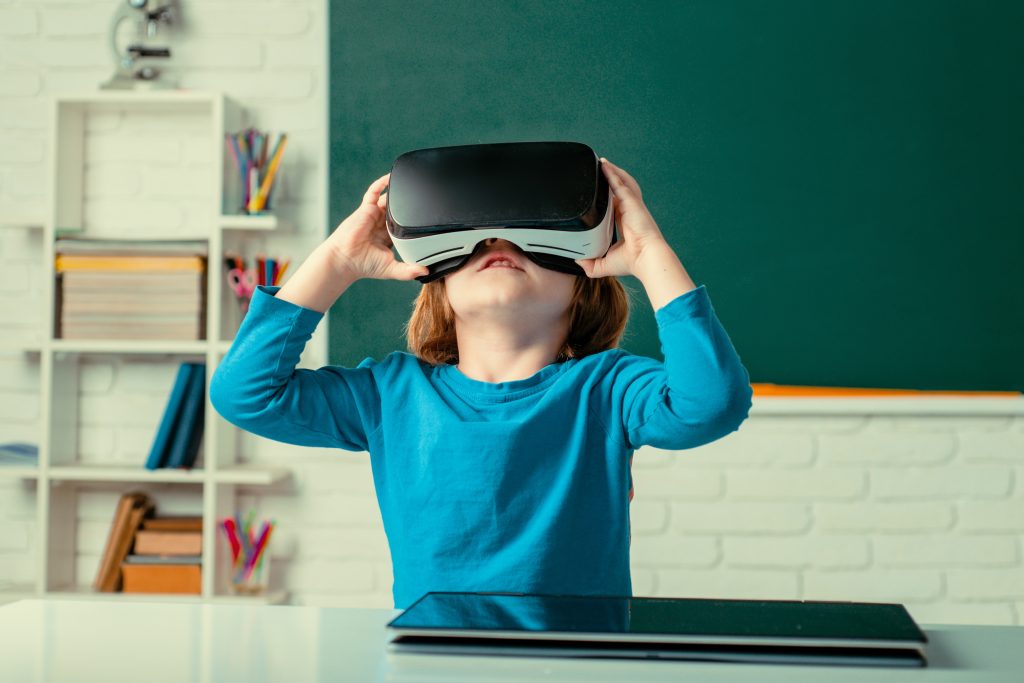Virtual reality technology has been making waves in various industries, and the field of education is no different. As an immersive, engaging and interactive learning tool, VR has the potential to change how students learn and develop new skills.
This blog explores the pros and cons of integrating virtual reality into education and talks about how this innovative technology can reshape traditional learning experiences.
Additionally, we’ll explore the future possibilities of VR in education and strategies for overcoming its implementation challenges.
Pros of Virtual Reality in Education
Enhanced Engagement and Immersion
One of the main benefits of using virtual reality in education is the enhanced level of engagement and immersion it offers. VR allows students to explore and interact with 3D environments, making learning more enjoyable while being stimulating and fun.
This improved sense of involvement enables students to retain information more effectively and develop a deep understanding of complex topics.

Improved Learning Outcomes
Research shows that students who learn through virtual reality display better information retention and higher test scores compared to traditional learning methods. The immersive nature of VR helps learners grasp abstract concepts more easily by providing them with visual representations and hands-on experiences.
Also read, What is Metaverse Sports and How will it Change the Sports World?
Access to Remote and Hazardous Learning Environments
Virtual reality enables students to virtually visit remote or hazardous locations, such as space or deep-sea environments, without leaving the classroom. This not only includes unique learning opportunities but also removes the risks and costs associated with field trips.
Customized Learning Experiences
VR technology allows these teachers to create tailored learning experiences for individual students. This tailored approach helps address the different needs of learners, ensuring that each student receives the right level of challenge and support.
Collaboration and Social Interaction
Virtual reality can also help with collaboration amongst students located in different geographic areas. By connecting learners in virtual environments, VR promotes teamwork, problem-solving, and interactive communication skills.
Virtual Reality in Education can help in Skill Development and Training
Virtual reality can be utilized for skill development and professional training across various fields and industries, such as engineering and healthcare. Students can practice risky procedures and acquire technical skills in a controlled and risk-free environment, leading to increased confidence and proficiency.

Motivation and Gamification
The gamification of learning experiences through VR can motivate students to engage more actively in the learning process. By including such elements of competitions and rewards, VR-based educational games can make learning more enjoyable and fun.
Cons of Virtual Reality in Education
High Costs
One of the main downsides of virtual reality in education is the high cost of implementation. VR hardware and software can be expensive, and schools may struggle to allocate higher budgets to adopt this technology.
Technological Limitations
While VR technology is rapidly advancing, it still has limitations. Some users are known to display motion sickness, and the quality of graphics can also differ. Moreover, the need for fast internet connections and powerful computers will present challenges for some educational institutions.
Limited Content Availability
Although the number of VR learning resources is growing, there is still a shortage of top-quality educational content. Teachers might need to invest time and effort in developing their own VR experiences or collaborate with developers to create suitable study materials for their pupils.
Potential for Distraction
The immersive nature of virtual reality can many-a-times lead to distractions. Students may become too focused on the technology itself rather than the learning goals, which could impact their overall learning experience in a negative way.

Training and Support Requirements
Integrating virtual reality into the classroom requires these educators to receive proper training and support. They must learn how to use VR technology effectively and modify their teaching methods accordingly to facilitate successful learning experiences.
Accessibility and Inclusivity
Not all students have equal access to VR technology due to a variety of reasons, such as financial, geographical, or physical constraints. Ensuring that VR experiences are accessible and inclusive for all learners is essential to avoid aggravating existing educational differences.
Ethical Considerations
The use of virtual reality in education raises ethical concerns about data privacy and the potential for misuse of personal information. Educational institutions must be vigilant and on the lookout for addressing these issues and ensuring that their students’ privacy is protected day in and day out.
The Future of VR in Education and Strategies for Overcoming Challenges
As virtual reality technology continues to advance, the possibilities for its application in education are boundless. To harness the full potential of VR, educators and policymakers must work together to overcome the challenges associated with its implementation.
Encouraging Collaboration
Developing partnerships between institutions, tech companies, and all these content developers can facilitate the creation of high-quality VR learning experiences. By combining resources and expertise, stakeholders can address challenges related to cost, content availability, and technological barricades.
Investing in Infrastructure
Governments and educational institutions should invest in the necessary budget allocation for the infrastructure to support the widespread adoption of virtual reality in education. This includes providing fast internet access, powerful computing devices, and proper training and support for educators.
Focusing on Inclusivity and Accessibility
Efforts should be made to ensure that virtual reality experiences are accessible to all students, regardless of their socioeconomic background or physical capabilities. This may involve developing low-cost VR solutions, creating adaptive VR environments, and designing educational content that is universally accessible.
Promoting Research and Evaluation
To better understand the impact of VR on predicting outcomes, continuous research and evaluation should be carried on. This will help identify best practices for using VR in education and inform future policy and investment decisions.
Conclusion
Virtual reality in education offers numerous benefits, including increased engagement, improved learning outcomes, and access to unique learning environments.
However, the technology also presents challenges, such as high costs, technological limitations, and limited content availability.
By carefully measuring and considering the pros and cons of virtual reality, teachers and educators can determine how best to incorporate this cutting-edge technology into their classrooms and curriculum.
The key to unlocking the full potential of virtual reality in education lies in fostering and bettering the collaboration among teachers, developers, and policymakers while addressing and slowly removing the barriers.
As we continue to embrace these possibilities of VR in education, we can look forward to a future where immersive, captivating, and tailored learning experiences are the norm, transforming the way students acquire knowledge, learn and develop new skills.